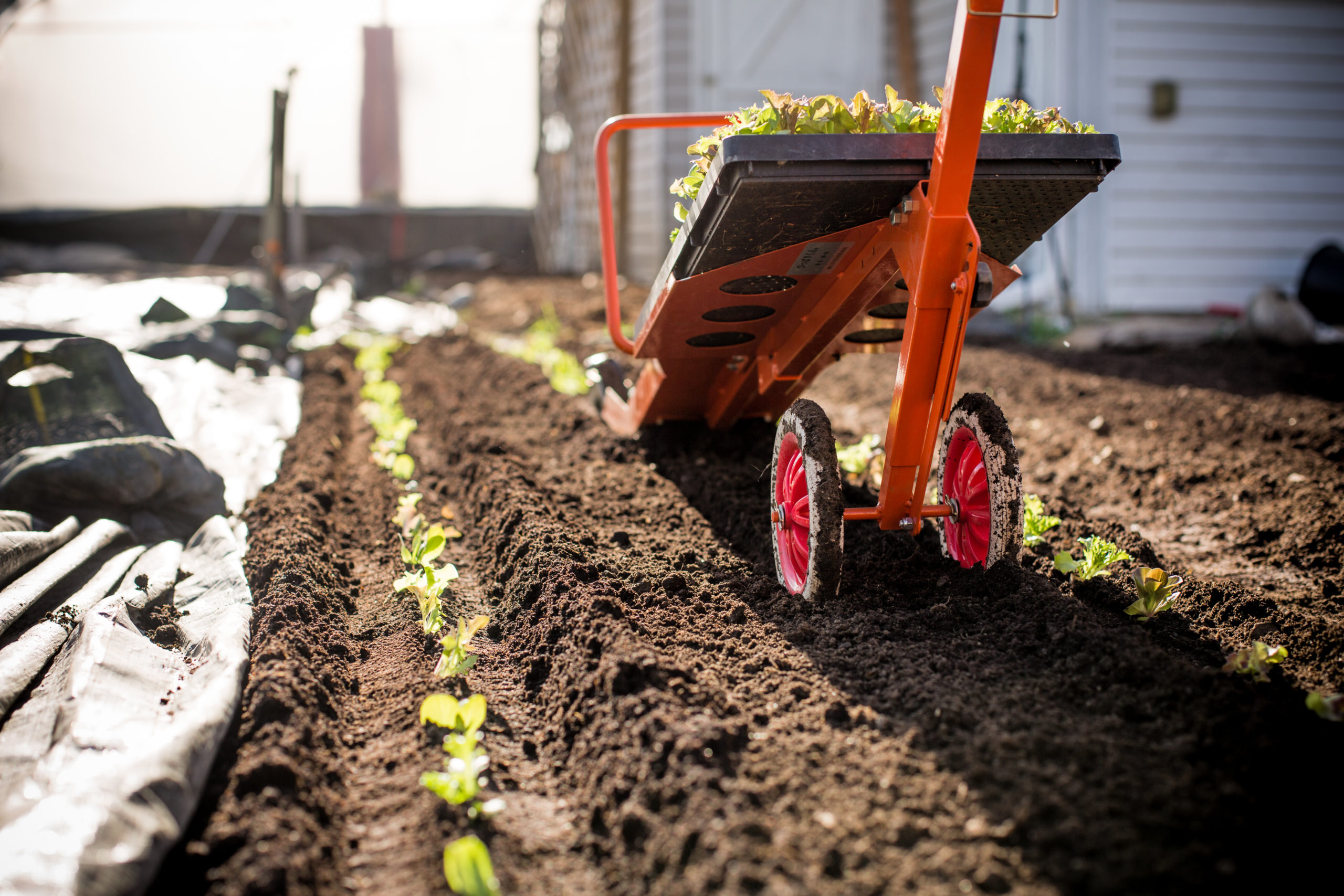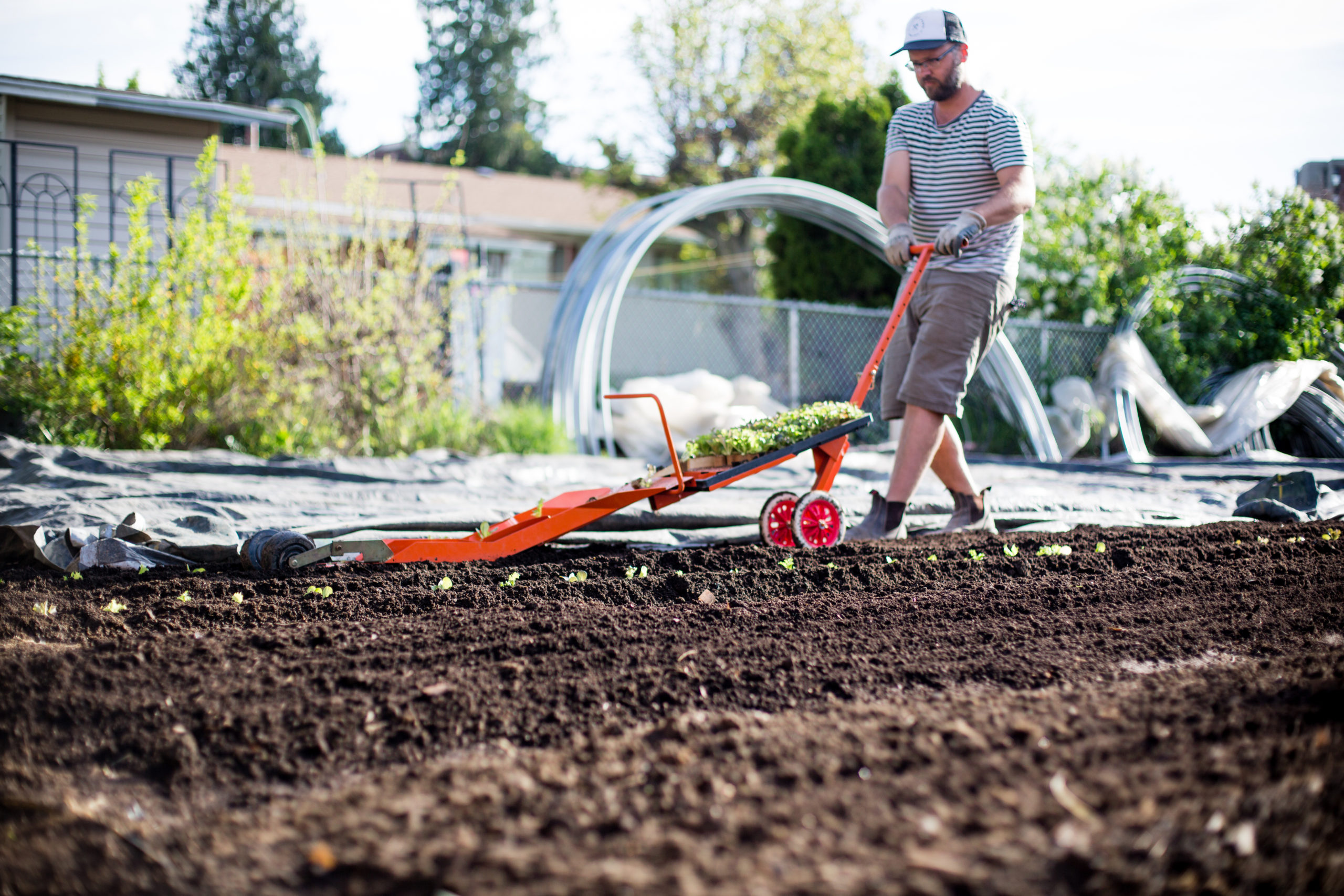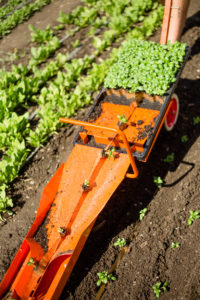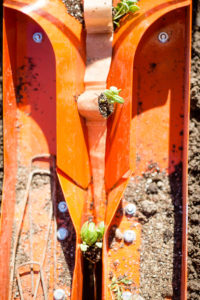
Mar 26, 2020
Paper pot transplanters in organic production
The recent National Organic Program (NOP) movement on paper pot transplanter systems – more specifically, the materials and adhesives used in the paper pot chains – in certified organic production is a long-awaited answer for many small farms. The paper pot transplanter has helped transform small/hand-scale farm systems with an efficient, labor-saving tool that greatly increases the ability of farmers to produce high-quality transplants that may otherwise be cost-prohibitive.
The paper pot system

The paper pot system is comprised of two main components: The paper pots and the associated hardware for seeding them. The paper pots come in compressed strips and are quickly expanded using purpose-made spreader bars and then placed in a frame, which holds the 264 cells per flat open. Chains are available in different in-row spacing and lengths for a diversity of crops; advanced options such as drop and vacuum are also available for the system.
The second component of the system is the transplanter itself. The single row transplanter, which is offered by Small Farm Works and Paperpot Co. for $950 as of early 2020, is a narrow cart with handles that holds a tray of transplants while being drawn down the row. The user needs to hand plant the beginning of the chain to offer resistance for the first couple of feet. The transplanter can then be pulled down the row and will open a furrow, feed the chain, close the furrow and press the soil in one pass.
The system is marketed as saving many hours of manual labor, allowing crops like head lettuce, scallions and onions to be transplanted in a fraction of the time. The system also opens up the possibility of transplanting crops that most producers wouldn’t consider worth the time, such as beets, spinach and carrots, though this practice would allow for earlier harvests and more consistent germination and spacing.
While the system does save time and there are many testimonials to its effectiveness, producers will need to keep in mind a number of factors to make the most of their investment. For crops that would typically be direct-seeded, such as beets or spinach, growers need to factor in the substantial expense of seeding labor and reduced greenhouse space. The small size of the cells means that particular attention needs to be paid to getting crops in the ground on time, especially to prevent roots from growing together and making the transplanting process less smooth. A two-week delay in transplanting could be devastating for transplant health, so growers should take into account their ability to consistently get transplants in during the spring.
The transplanter requires fastidious bed preparation and finely worked soil to ensure that chains are completely buried and soil flows smoothly around the simple opener and closer mechanisms. Clods, debris and uneven beds will mean time spent manually burying the chains. Additionally, because the chains are surprisingly slow to decay in the field, cultivation becomes a more delicate task. Mechanical and in-row cultivation risk catching the chain and ripping stretches of plants from the ground. Managing the weed seed bank through stale bedding techniques and reduced seed rain in previous rotations are essential.
Even if conservative math pencils the system in as a break-even-to-slight-benefit financially, growers will appreciate the reduction in time spent on hands and knees, leaving more energy and enthusiasm for other tasks, particularly during early spring plantings. The system also affords more flexibility and earliness in crop planning, meaning it will likely continue to see an increasing number of producers invest in it for heated and unheated tunnel production, as well as for high-value field crops.
History of use in the NOP

The introduction of the paper pot system in the United States is largely credited to John Hendrickson of Stone Circle Farm, who brought the transplanter from Japan in 2006 and now operates Small Farm Works, the U.S. representative for Nitten, one of the top manufacturers of the system. He was able to work with his certifier to approve its use in his system, due to its materials being similar in origin and use to a paper mulch, which is allowed under NOP ruling.
While many certifiers across the U.S. originally gave the paper pot system the green light as its popularity spread over the next 12 years, the February 2018 NOP’s decision suspended the use of the system for the 2019 season and beyond. This was largely due to the lack of consensus among certifiers in approving the system, as well as the use of virgin paper products and synthetic adhesives used in the chain’s manufacturing. A petition to the National Organic Standards Board (NOSB) by Hendrickson and others lead to a reversal of this decision in February 2019, following the NOSB’s request to allow the use of the chains in 2019 while they reconsider the ruling and the language in the NOP regarding virgin paper product use in organic systems. This petition specifically asked to add paper pots to the National List of Allowed and Prohibited Substances under section §205.601(o) as a production aid, which would specify “Plant pot or growing container-hemp or other paper, without glossy or colored inks.”
The current rulings for paper product use, according to the NOP, are listed as:
“Includes newspaper and other recycled paper such as cardboard, without glossy or colored inks. Does not include paper that is not recycled (i.e., virgin paper). Permitted as mulch or as a compost feedstock. Reference: 7 CFR 205.601(b) & 205.601(c).”
The ambiguity of this ruling has brought forth discrepancies for the NOP to rule specifically on the paper chains used in paper pot transplanting systems. As has been identified, the use of virgin paper is currently not permitted, which the current chain materials would fall under. Many advocates for the acceptance of paper pot systems point out that recycled materials that are currently acceptable in organic systems (i.e., cardboard) also contain the synthetic adhesives that are used in the chains’ manufacturing.
Following the petition to the NOSB in Aug. 15, 2018, a NOSB crops subcommittee commissioned a technical report on the substances used in production of paper pot chains, which was published in July of 2019. Based on the results of the report, the subcommittee identified in their August, 15 2019 discussion document that there were few differences between the paper products currently allowed under organic ruling, and the substances used in the production of the paper pot chains. The subcommittee voted unanimously to approve the discussion document.
What does the recent decision mean?

While the use of paper pot transplanters is currently under NOSB review, the documents written by the crops subcommittee indicate the general approval and acceptance of the paper pot transplanter system within certified organic production systems.
The permissibility of the paper pot system in the past was clouded by the narrow and specific language of the two references in the organic regulations for newspaper and recycled paper products. Comments made in support of the inclusion of paper pot chains in organic standards also request the general review of other paper-based products such as cloches, collars, and seed tape used in production systems. Broadening the regulatory language will help clarify for producers and certifiers the different paper-based products available for use in organic systems, and perhaps prevent similar situations from occurring in the future.
Farms that have been following the status of the paper pot system may finally see some resolution in 2020 with the pending addition of the paper pot chains to the NOP, and with it a structure to ensure that all organic farms have access to this new technique.
For Further Reading
John Hendrickson. 2018. “Paper Pot or Container Petition 080718.”
National Organic Standards Board. 2019. “Crops Subcommittee Petitioned Material Discussion Document Paper (Plant Pots and Other Crop Production Aids).”
Brian Baker, Tina Jensen Augustine, Doug Currier, Lindsay Kishter, & Rachel Lanspa. 2019. “Paper Pots and Containers Technical Report Final 726.”
Sarah Diana Nechamen. (2014, July 8). Investigating the Profitability of the Paper Pot Transplanter on a Small Scale Vegetable Farm.
Hendrickson, J. (n.d.). Our Story.






